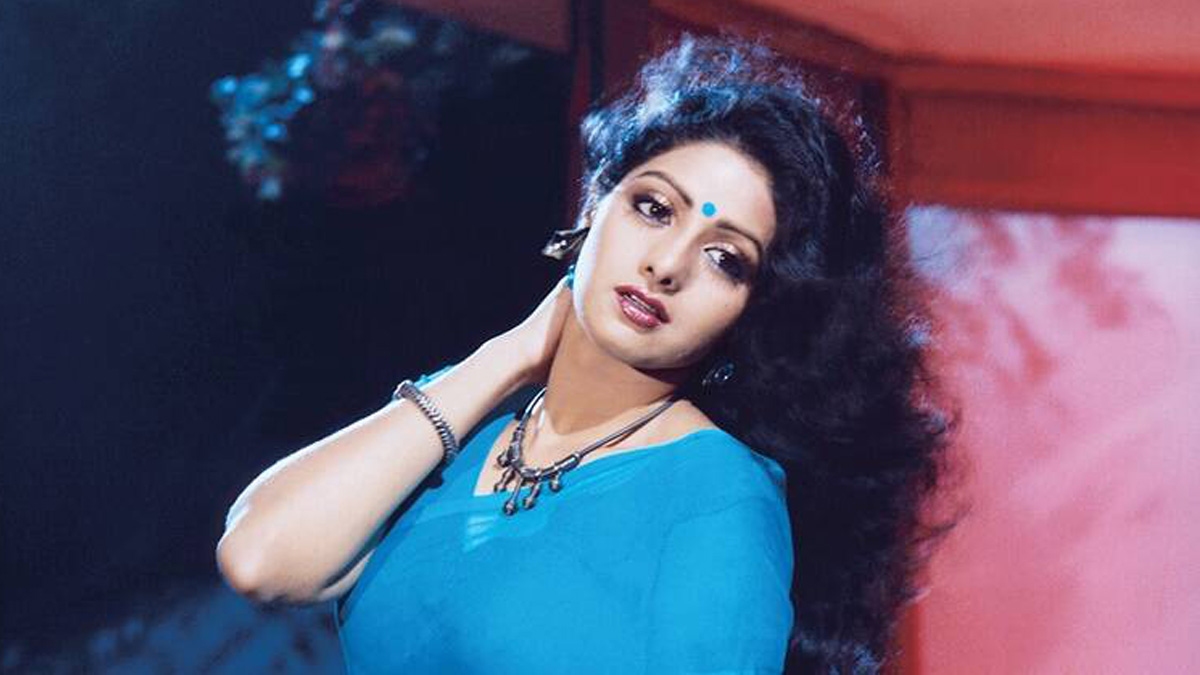
Sridevi’s Expressive Eyes and Thunder Thighs: The Story of Her Journey to Becoming a Star

If Hindi cinema is the opium of the masses, Sridevi was its biggest supplier in the 1980s. With a roll of her eyes and a shimmy of her hips, she became a stairway to heaven for millions of sweaty cinegoers in sweatier theatres. Across India, her photographs adorned autorickshaws, her posters hung in barber shops, and her poses provided amiable employment to calendar artists.
Who is the hero of Nagina or Mr. India? Who is the centre of attraction in Chaalbaaz or Chandni? In these films, made by established production houses, A-list heroes played supporting acts. These films revolved around her. And they were all runaway hits. Her clout can be judged by K.C. Bokadia’s rare flop, Main Tera Dushman (1989), where Sridevi rescues hero Jackie Shroff from the clutches of the villain and delivers more punches than him in the fight scene that follows. She, not the ‘hero’ with facial hair, hacks down the villain (Anupam Kher). In an era when heroines were often effaced from the climax, Sridevi radically recast the gender script.
The 1980s were her most prolific years. She acted in a staggering 150-odd Tamil, Telugu and Hindi films in that period, roughly fifteen films a year. Many were forgettable but generally Sridevi managed to rise above the rubble. Like any good artiste, she was often better than the movie.
In Hindi films, Sridevi had first worked as a pre-teen in Julie (1975) but made her debut in Bharathiraja’s Solva Sawan (1979). She triggered a tsunami with Himmatwala (1983). Producer G.A. Seshagiri Rao recalled that Jaya Prada had originally played the role of the bold and brassy daughter of a zamindar in the Telugu version. ‘Bombay film industry wanted us to take Jaya Prada, not Sridevi. But we wanted to introduce someone new,’ he said.
There was nothing new or remarkable about the part or the film, which had traces of The Taming of the Shrew. But the public enjoyed her adipose-friendly voluptuousness and her easy dance movements. There was something paisa vasool about her that Mawaali (1983) and Tohfa (1984) further established. One of the most enduring images of 1980s Bombay cinema is Sridevi dressed like an apsara, sitting among rows and rows of copper vessels in Tohfa.
Many years later, Sridevi was asked if she was peeved by the tag ‘Thunder Thighs’, which gossip magazines used for her. She said, ‘It [the tag] was given to me at the time of Himmatwala. I was very chubby then, I weighed 75 kg. At the time of Chandni, I lost weight and came down to 57 kg, which I think helped me a lot to improve my dancing.’
What fresh ingredient did Sridevi bring to the table? Film critic Deepa Gahlot wrote, rather presciently, in January 1984, ‘This girl has brought with her the oomph of Mumtaz, the discipline of the South, talent [Sadma] and charm entirely her own and joined the race for superstardom which she shows all signs of winning…’
When the Eighties began, the Hindi film industry had two batches of heroines at work. Some had made their debuts in the early 1970s or earlier: Hema Malini, Zeenat Aman, Rekha, Parveen Babi and Reena Roy. Rekha was in her prime and pomp. Hema and Zeenat were still the prima donnas but, to use a golf analogy, in the back nine of their careers.
GenNow was Padmini Kolhapure, Rati Agnihotri, Poonam Dhillon, Anita Raaj, Tina Munim, Amrita Singh and Kimi Katkar. All debuted on different dates but were poised to take the big leap.
But Sridevi overtook them all. Suffering Savitri in family dramas or fun girl in frothy entertainers, she could do them both. As producer G.A. Seshagiri Rao put it, ‘Generally heroines were either performance-oriented or good-looking. Sridevi was a combination of both.’
But above all, she could build an invisible bridge that dissipated the distance between the viewer and the performer.
At the end of 1984, columnist Ali wrote in Screen, ‘People forgot the Sridevi of Solva Sawan and fell in love madly with the Sridevi of Himmatwala, Mawaali, Maqsad, Sadma, Tohfa and Naya Kadam. The love affair grew stronger with time. She was pronounced the No. 1 heroine and there were no two opinions—not even amongst the other younger heroines who were in the race.’
Simply put, Sridevi brought in a fusion of elements that others couldn’t. Her dance moves were marked by effortlessness, an uncontrollable energy and a sense of fun. In Nagina, there is a manic intensity in her no-holds-barred, choreographed battle with Amrish Puri. As the years passed by, Sridevi kept reinventing herself and offering something new. One had glimpsed her comic timing in the ribald Masterji (1985) but the star took it to another level in Mr. India (1987) and Chaalbaaz (1989). Her mimicking of Raaj Kumar and Charlie Chaplin are some of the most fun moments of 1980s Hindi cinema.
Fellow performer Rameshwari said, ‘Amitabh Bachchan had the ability to make any ridiculous situation look convincing. Sridevi also had that ability. She could do anything. She had a hunger to do more, like Mr Bachchan.’
In an interview, Sridevi once said that exposing body was unavoidable on the way up. ‘Any artiste at the beginning of her career doesn’t mind doing some bold scenes and wearing revealing clothes. That is necessary for glamour as well as for inching your way up. But slowly, one must give up these things and get into doing good roles.’
A stylish romance, Yash Chopra’s Chandni (1989) belonged to that category. The truth is Sridevi also put Chopra back in the list of A-plus directors. The film was his first major hit in the 1980s. With Chandni, Sridevi signed off the decade on a triumphant note, even though fresh competition was around the corner: Madhuri Dixit (Tezaab, 1988) and Juhi Chawla (QSQT, 1988). She was on top of her game, and at the very top when the Eighties ended.
– The Print












Comments